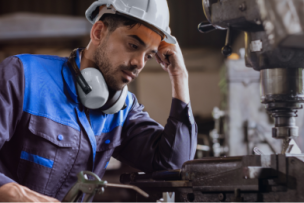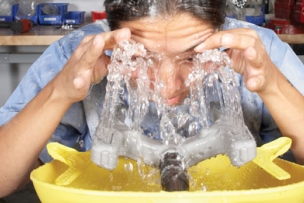Workplace eye injuries are a serious problem. According to PreventBlindness.org, more than 2,000 workers experience an eye injury on the job every day, and about 1 in 10 of these injuries require missed workdays. In addition, “of the total amount of work-related injuries, 10 (percent) to 20 percent will cause temporary or permanent vision loss,” the organization states.
Here, industry insiders discuss advances in eye protection, how to prevent misuse and how to best communicate to workers the importance of eye safety.
What’s new
The workplace, in general, is more technologically advanced than ever, but with all this technology comes more screen time on the job. Screen time can result in glare, which can lead to eyestrain and fatigue.
“Anti-glare technology helps to minimize this,” said Dave Matela, general manager of industrial business, North America, for Roswell, GA-based Kimberly-Clark Professional. “However, it’s essential that anti-glare eyewear also provides impact protection. Conventional computer glasses won’t protect workers from debris and other hazards that could cause permanent loss of vision.”
Avoiding misuse
Safety eyewear should never be treated as “one size fits all,” according to Eric Henzie, marketing manager of industrial safety for Latham, NY-based Protective Industrial Products Inc. “The proper fit of safety eyewear depends on facial features, eyesight, personal preference as it relates to comfort and the wearer’s work environment,” Henzie said, adding that it’s imperative employees are taught how to properly select safety eyewear for their work applications.
Katie Mielcarek, marketing manager for Cleveland-based Gateway Safety Inc., said workers should be cautious of extremely lightweight safety eyewear and careful to check the eyewear meets the ANSI Z87+ standard for high impact. “Manufacturers that are producing lightweight products by removing material from the lenses (making the lenses thinner) are skimping on quality, and these products can often fail ANSI Z87 impact testing,” she warned.
Fortunately, Mielcarek said, quality is easy to check. “Employers should make sure the safety eyewear for their employees is independently, third-party tested and certified to meet ANSI Z87+,” she said. “This is indicated by an additional mark or logo (such as UL) somewhere on the product. As an added measure to ensure quality, all eyewear – even the lightweight ones – should meet the military impact resistance standard for eyewear.”
Good advice
“Eye protection must be durable, comfortable and fit properly,” said Matela, adding that style and color choices are important, especially for young workers. “[These options] all affect how workers look and feel in protective eyewear, potentially tipping the scale between protection and injury.”
Watch this short video: KleenGuard's® Nemesis™ protective eyewear
Employers should take care when selecting eyewear for their workers, Mielcarek said. “Employers who choose high-quality, comfortable safety eyewear, not just the cheapest off the rack, send an important message to their employees, that they value their safety.”
Henzie added that employers need to encourage accurate fit testing and “a more progressive stance on compliance through education.”
Compiled with the assistance of the International Safety Equipment Association.
Previously Featured in Safety & Health Magazine.
Browse protective eyewear from Kimberly-Clark Professional's KleenGuard brand on MSCDirect.com.







Talk to Us!
Leave a reply
Your email address will not be published. Required fields are marked *